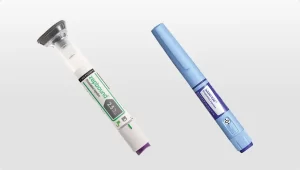 When considering prescription medications for weight loss, two common options are Zepbound (tirzepatide) and Saxenda (liraglutide). While both support weight management, they differ in formulation, dosing, side effects, and long-term effectiveness. Let’s break down their similarities and differences so you can make an informed choice.
When considering prescription medications for weight loss, two common options are Zepbound (tirzepatide) and Saxenda (liraglutide). While both support weight management, they differ in formulation, dosing, side effects, and long-term effectiveness. Let’s break down their similarities and differences so you can make an informed choice.
Zepbound vs Saxenda Comparison Table
| Feature | Zepbound (Tirzepatide) | Saxenda (Liraglutide) |
|---|---|---|
| FDA Approval | Approved in 2023 for chronic weight management | Approved in 2014 for chronic weight management |
| Mechanism of Action | Dual GIP & GLP-1 receptor agonist | GLP-1 receptor agonist |
| Administration | Weekly injection | Daily injection |
| Dosage Options | 2.5 mg to 15 mg (weekly) | 0.6 mg to 3 mg (daily) |
| Average Weight Loss | Up to 22.5% of body weight in trials | Around 5–10% of body weight in trials |
| Common Side Effects | Nausea, vomiting, diarrhea, constipation, fatigue | Nausea, vomiting, diarrhea, constipation, low appetite |
| Cost | Often higher due to newer drug status | Typically lower than Zepbound |
| Insurance Coverage | Limited, varies by plan | Broader coverage due to longer availability |
| Best For | Patients seeking maximum weight loss results and less frequent dosing | Patients preferring a longer-established option with more insurance support |
Key Takeaways
-
Zepbound is a newer, highly effective option with weekly dosing and greater average weight loss results. It is manufactured by Eli Lilly
-
Saxenda is more established, widely covered by insurance, but requires daily injections and may result in less dramatic weight reduction. It is manufactured by Novo Nordisk
-
Choice often depends on your treatment goals, insurance coverage, and tolerance to injections.
